“I don’t like to say I have given my life to art. I prefer to say art has given me my life.” – Frank Stella –
Who Is Frank Stella?
Frank Stella (born May 12, 1936) is an American painter and printmaker widely regarded as one of the most important figures in the development of geometric abstraction and Minimalism. His work has evolved significantly over the course of his career, incorporating not only painting but also sculpture and printmaking. Known for pushing the boundaries of traditional art forms, Stella’s bold and innovative use of color, geometry, and form has made him one of the most influential contemporary artists.

The Black Paintings (1958 -1960)
One of Stella’s most iconic and earliest series, The Black Paintings marked the beginning of his exploration into minimalism and geometric abstraction. These works, created between 1958 and 1960, are characterized by their stark simplicity—thin bands of black paint on raw canvas. The repetitive, angular patterns of stripes are arranged in horizontal bands that often change in width, creating a rhythm across the surface.
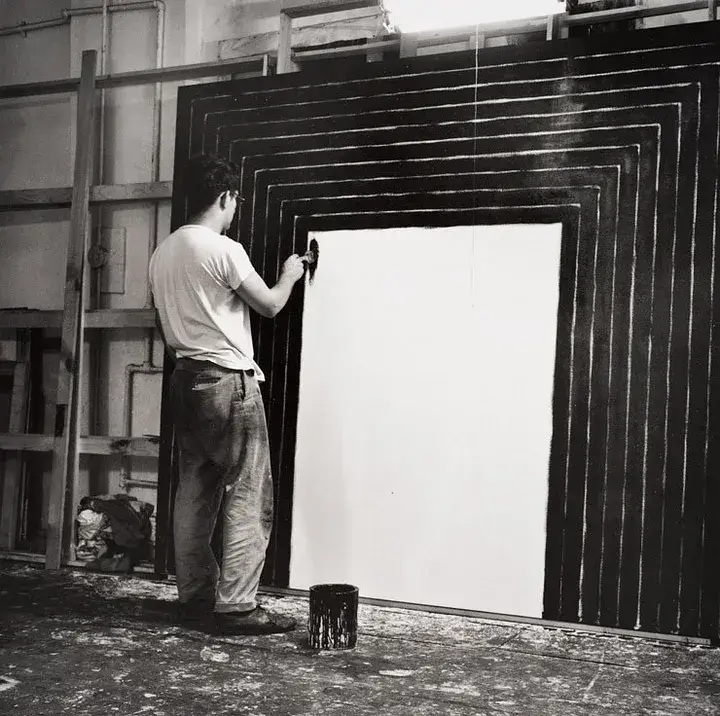
In The Black Paintings, Stella deliberately rejected the emotional and gestural abstractions of Abstract Expressionism, focusing instead on pure form and structure. His use of black as the sole color was a radical move, emphasizing the physicality of the medium itself rather than attempting to evoke emotions or create illusionistic depth. These works are devoid of representational elements, challenging the viewer to experience the art purely in terms of its geometric patterns and surface qualities.
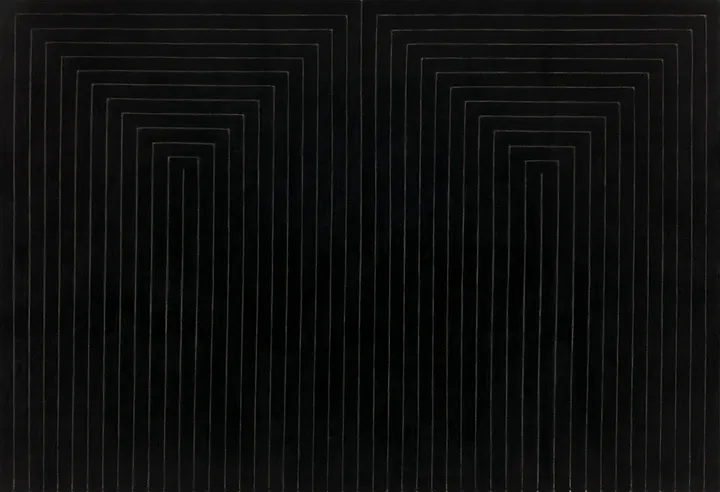
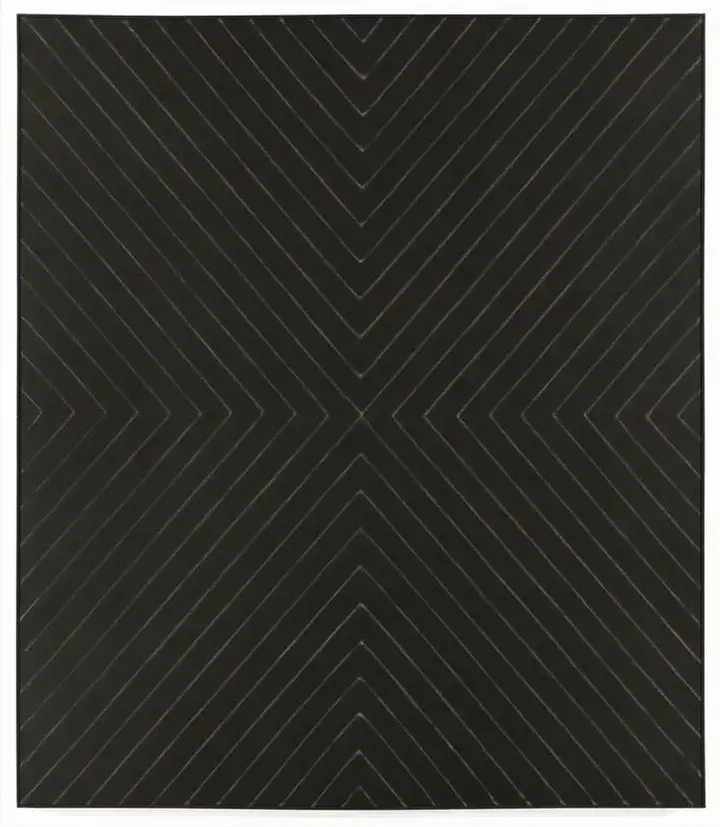
One of the most famous works in this series is Die Fahne Hoch (1959), which consists of a series of black stripes against a white background. The sharp lines of this painting draw attention to the surface of the canvas, emphasizing that what the viewer is seeing is simply the material itself.
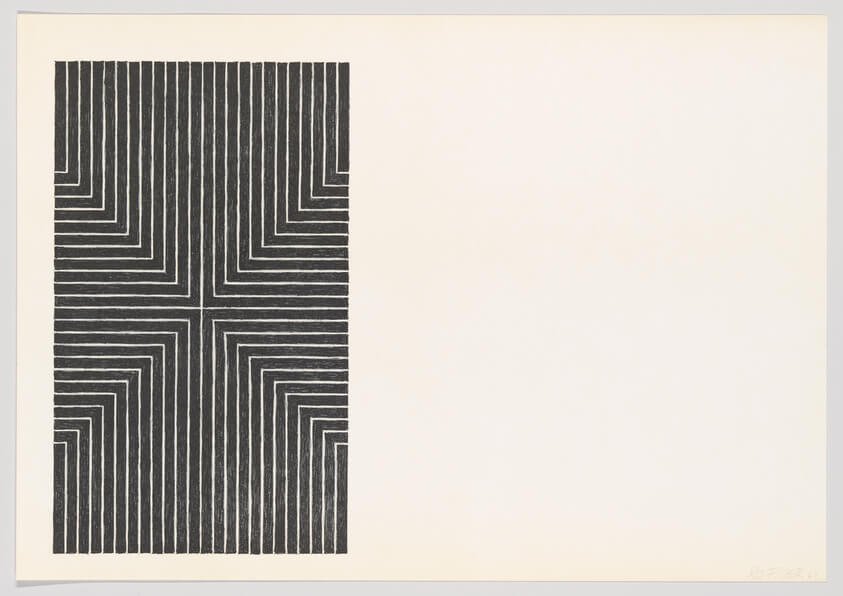
The Protractor Series (1967-1971)
Frank Stella’s Protractor Series is one of his most important and visually striking bodies of work. These paintings, created between 1967 and 1971, represented a departure from his earlier minimalist works by incorporating sweeping curves and vibrant colors. Stella’s inspiration for this series came from the use of a protractor—a tool used for measuring angles—which allowed him to explore the geometric possibilities of curved lines.
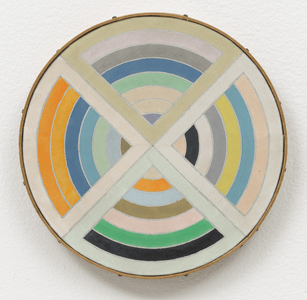
The Protractor Series features concentric arcs radiating outward from the center of the canvas, in compositions that are rich in color and movement. The dynamic visual rhythm of the works creates a sense of flow, as the arcs and shapes appear to move and shift. Stella used bright, complementary colors such as reds, yellows, and blues, giving these works a sense of energy and vibrancy. This series was a dramatic departure from his earlier austere black-and-white works and marked a significant expansion of his exploration of geometric abstraction.
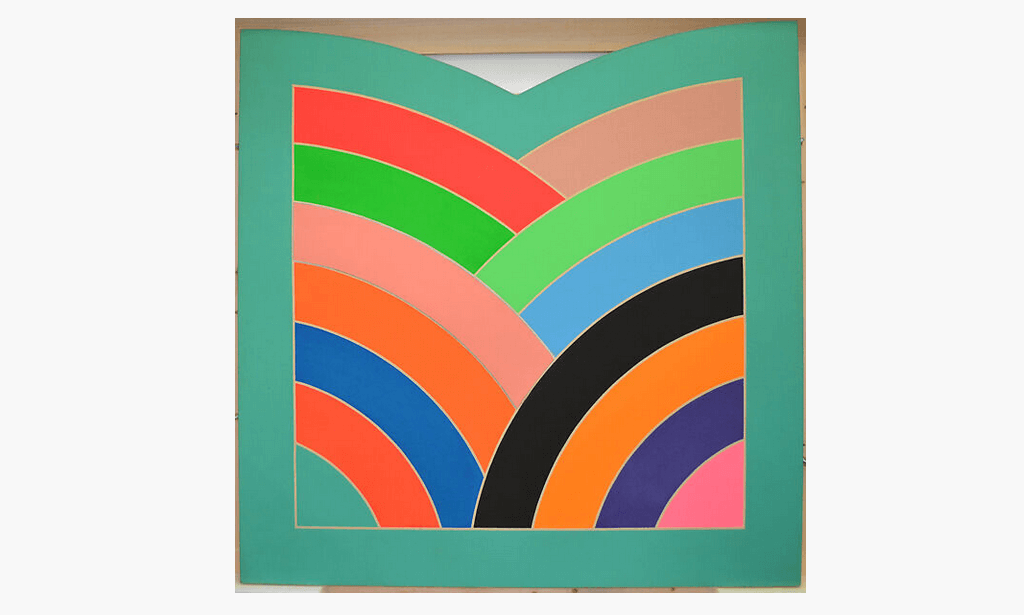
Notable works in this series include Harran II (1967) and Sinjerli Variation I (1977), both of which showcase Stella’s mastery of curved forms and color theory. These works are often regarded as a turning point in Stella’s career, as they represent an attempt to blend the rigid structures of geometry with the dynamic energy of color and form.

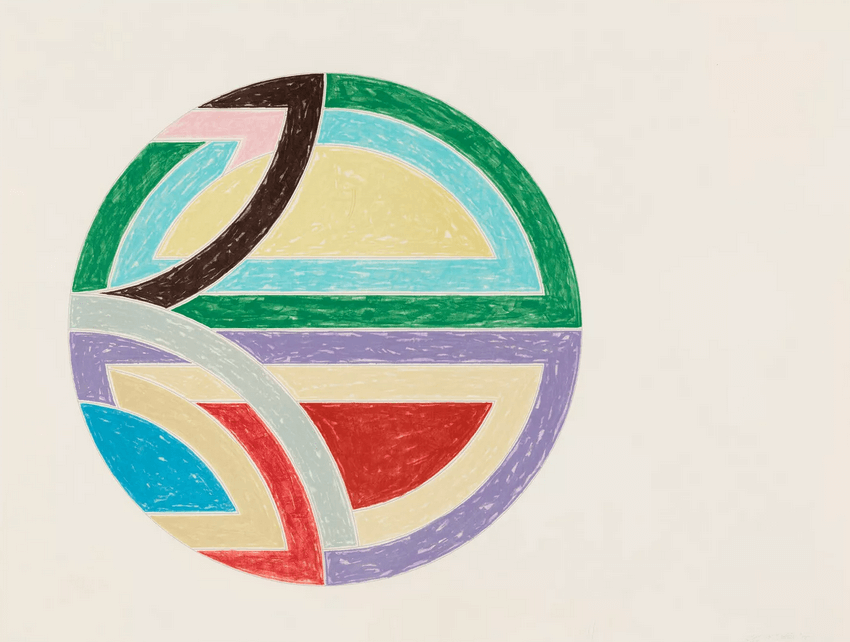
The Shaped Canvases (1960s–1970s)
Throughout the 1960s and 1970s, Stella began to experiment with the very shape of the canvas itself. Moving beyond the traditional rectangular format, he created works in irregular shapes, often inspired by complex geometric forms such as polygons, stars, and other non-rectangular figures. This experimentation with the canvas’s physical form was another way Stella sought to challenge traditional ideas about the boundaries of painting.
One of the most famous works in this category is Hyena Stomp (1962), where Stella employed a multi-part, irregular-shaped canvas that appears to expand into the viewer’s space. The work is composed of overlapping, brightly colored, polygonal shapes arranged in a dynamic, asymmetrical composition. The visual impact of Hyena Stomp is further amplified by the irregular form of the canvas, which moves away from the two-dimensionality of traditional paintings. The work creates a visceral, almost sculptural experience for the viewer.
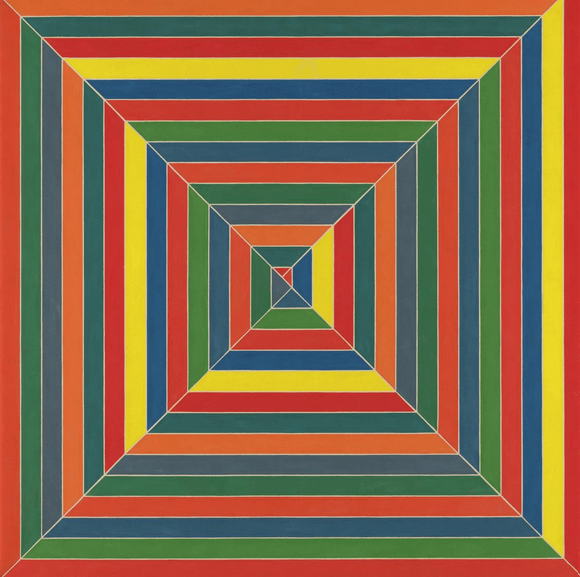
Similarly, works like The Marriage of Reason and Squalor II (1959) and Polish Village (1983) showcase Stella’s growing interest in pushing the boundaries between painting and sculpture. By extending the canvas beyond the conventional rectangle and incorporating additional sculptural elements, Stella was able to create immersive works that invited the viewer to engage with the piece from multiple perspectives.
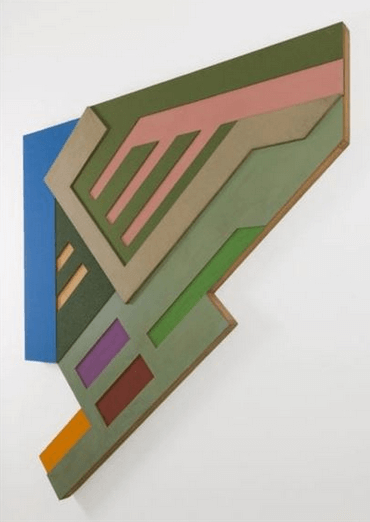

The Moby Dick Series (1984-1985)
The Moby Dick series, created in the mid-1980s, is one of Stella’s most ambitious and highly regarded bodies of work. Inspired by Herman Melville’s iconic novel Moby-Dick, these paintings represent Stella’s attempt to convey the vastness and complexity of the story through a visual language of geometric abstraction. The series includes large-scale paintings with elliptical shapes and bold, contrasting colors that evoke the oceanic themes and chaos of the narrative.
In works like Moby Dick I (1985) and Moby Dick II (1985), Stella used sweeping curves, angular lines, and vibrant colors to represent the sense of movement and energy inherent in the sea. The circular forms in these works suggest the cyclical nature of the story, while the bright, contrasting colors symbolize the turbulent and unpredictable forces that are central to the novel.
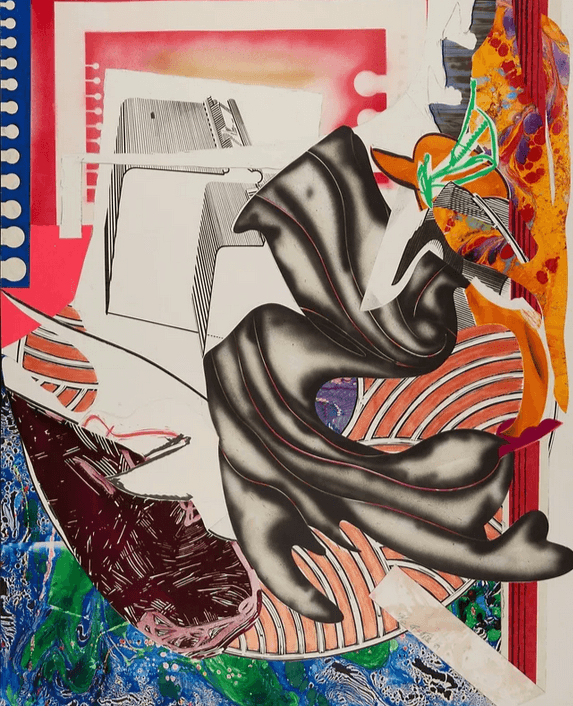
These paintings also demonstrate Stella’s ongoing engagement with the idea of abstraction as a means of representing complex narratives. In many ways, the Moby Dick series can be seen as a culmination of his earlier work with geometric abstraction, combining both visual complexity and a narrative dimension that had previously been absent from his practice.
The Polychrome Series (1980s)
In the 1980s, Stella’s work evolved once again as he embraced the use of multiple colors and intricate geometric patterns. The Polychrome Series is a prime example of his mature style, blending his earlier use of sharp geometric shapes with a newfound emphasis on color. These works often feature overlapping, multi-dimensional shapes that give the impression of both movement and depth.
One of the most significant pieces in this series is The Scramble (1989), a large-scale painting composed of angular, interlocking shapes and a vibrant color palette. The dynamic composition of The Scramble creates a sense of movement, with the overlapping forms pulling the viewer’s eye across the canvas in a continuous flow. The work is also notable for its complex structure, which combines the sharp geometry of earlier works with the organic energy of the more recent pieces in Stella’s oeuvre.
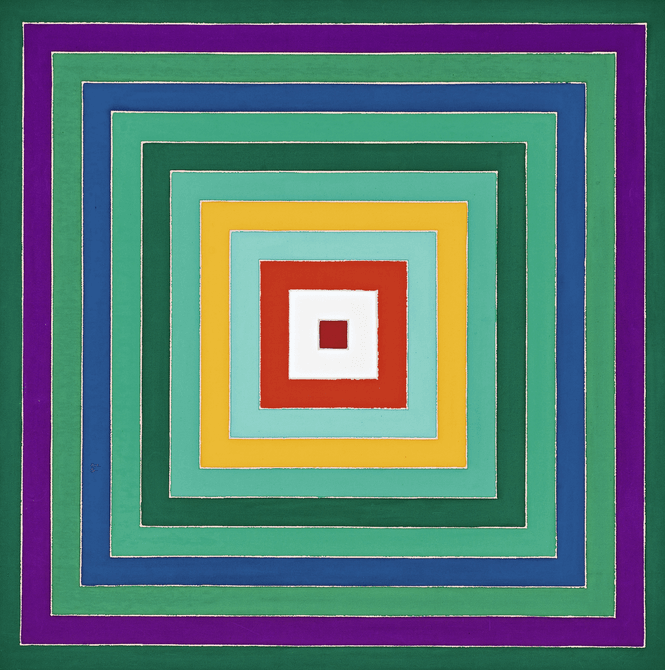
The Polychrome Series represented a turning point in Stella’s career, as it blended the formalist abstraction he had been known for with a new sense of dynamism and complexity. His growing interest in exploring the relationship between color, form, and space continued to evolve, and the Polychrome Series was one of the most striking expressions of this.
Frank Stella’s Legacy
Frank Stella’s impact on modern art has been profound. His rejection of traditional representation and his embrace of abstraction, especially geometric abstraction, played a central role in the development of the Minimalist and post-Minimalist movements. He continually pushed the boundaries of what painting could be, experimenting with shape, color, and material in ways that would influence subsequent generations of artists.

Stella’s work has been exhibited worldwide, and his paintings, sculptures, and prints are housed in major museums and collections, including the Museum of Modern Art (MoMA) in New York, the Tate Gallery in London, and the Guggenheim Museum. His innovative use of form, color, and space continues to be an inspiration for contemporary artists working in a wide variety of media.
Stella’s commitment to abstraction, his focus on formalism, and his exploration of new materials and techniques have secured his place as one of the most important figures in 20th-century art. He remains an active artist, still creating new work and contributing to the ongoing dialogue about the possibilities of abstraction in contemporary art.

